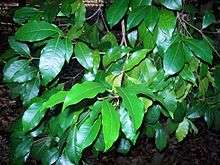Bosistoa transversa
| Yellow Satinheart | |
|---|---|
 | |
| Scientific classification | |
| Kingdom: | Plantae |
| (unranked): | Angiosperms |
| (unranked): | Eudicots |
| (unranked): | Rosids |
| Order: | Sapindales |
| Family: | Rutaceae |
| Genus: | Bosistoa |
| Species: | B. transversa |
| Binomial name | |
| Bosistoa transversa J.F.Bailey & C.T.White | |
Bosistoa transversa, known as the Yellow Satinheart, is a rainforest tree found in eastern Australia. A member of the citrus family, it is rare plant, rated as vulnerable. It occurs from Mullumbimby in north eastern New South Wales to Gladstone, Queensland. The habitat is lowland sub-tropical rainforest.
The tree was first described in 1917 by Queensland botanists John Frederick Bailey and Cyril Tenison White.[1] The generic name Bosistoa honours the name of Joseph Bosisto, a manufacturer of essential oils. The specific epithet transversa refers to the transversal ribbed carpels of the fruit.[2]
Bosistoa transversa is a small to medium tree, with a cylindrical and sometimes crooked trunk, which can reach 15 m (49 ft) in height. The trunk reaches 20 cm (8 cm) across and has mostly smooth dark brown bark with irregular horizontal ridges. The leaves are arranged oppositely on the thin brown or grey-brown branches and are made up of one to three roughly oval shaped glossy leaflets, which measure 1–6 cm (0.5–2.5 in) wide and 4 to 12.5 cm (1.6 to 4.9 in) long with a pointed apex. The leaves have prominent oil glands. Appearing from January to March, the tiny white flowers are arranged in white panicles which are terminal or near terminal and measure 7–16 cm (3–6.5 in) in length, The flowers themselves are around 3.5 mm long and have five sepals measuring 1 mm long, and five petals ovals around 3 mm long. Flowering is followed by pairs of small woody fruit which ripen over May to July.[2]
The Yellow Satinheart is found in subtropical rainforest in lowland areas, below an altitude of 300 m (980 ft).[3]
The Yellow Satinheart is classified as threatened in New South Wales; threatening processes include clearing of rainforests, invasion of remaining rainforest areas by weeds, and grazing by livestock.[3]
References
- ↑ "Bosistoa transversa J.F.Bailey & C.T.White". Australian Plant Name Index (APNI), IBIS database. Centre for Plant Biodiversity Research, Australian Government.
- 1 2 Floyd, A.G., Rainforest Trees of Mainland South-eastern Australia, Inkata Press 2008, ISBN 978-0-9589436-7-3 page 353
- 1 2 "Yellow Satinheart - profile". Threatened species, populations and ecological communities of NSW. NSW Department of Environment and Conservation (DEC), New South Wales Government. 1 September 2005. Retrieved 11 December 2010.
